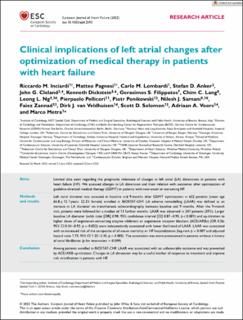Clinical implications of left atrial changes after optimization of medical therapy in patients with heart failure
Inciardi, Riccardo M.; Pagnesi, Matteo; Lombardi, Carlo M.; Anker, Stefan D.; Cleland, John G.; Dickstein, Kenneth; Filippatos, Gerasimos S.; Lang, Chim C.; Ng, Leong L.; Pellicori, Pierpaolo; Ponikowski, Piotr; Samani, Nilesh J.; Zannad, Faiez; van Veldhuisen, Dirk J.; Solomon, Scott D.; Voors, Adriaan A.; Metra, Marco
Journal article, Peer reviewed
Published version

Åpne
Permanent lenke
https://hdl.handle.net/11250/3027844Utgivelsesdato
2022Metadata
Vis full innførselSamlinger
- Department of Clinical Science [2318]
- Registrations from Cristin [9791]
Sammendrag
Aims
Limited data exist regarding the prognostic relevance of changes in left atrial (LA) dimensions in patients with heart failure (HF). We assessed changes in LA dimension and their relation with outcomes after optimization of guideline-directed medical therapy (GDMT) in patients with new-onset or worsening HF.
Methods and results
Left atrial diameter was assessed at baseline and 9 months after GDMT optimization in 632 patients (mean age 65.8 ± 12.1 years, 22.3% female) enrolled in BIOSTAT-CHF. LA adverse remodelling (LAAR) was defined as an increase in LA diameter on transthoracic echocardiography between baseline and 9 months. After the 9-month visit, patients were followed for a median of 13 further months. LAAR was observed in 247 patients (39%). Larger baseline LA diameter (odds ratio [OR] 0.90; 95% confidence interval [CI] 0.87–0.93; p < 0.001) and up-titration to higher doses of angiotensin-converting enzyme inhibitors or angiotensin receptor blockers (ACEi/ARBs) (OR 0.56; 95% CI 0.34–0.92; p = 0.022) were independently associated with lower likelihood of LAAR. LAAR was associated with an increased risk of the composite of all-cause mortality or HF hospitalization (log-rank p = 0.007 and adjusted hazard ratio 1.73, 95% CI 1.22–2.45, p = 0.002). The association was more pronounced in patients without a history of atrial fibrillation (p for interaction = 0.009).
Conclusion
Among patients enrolled in BIOSTAT-CHF, LAAR was associated with an unfavourable outcome and was prevented by ACEi/ARB up-titration. Changes in LA dimension may be a useful marker of response to treatment and improve risk stratification in patients with HF.
